Successful pedestrian places provide public space that is attractive and functional, feels comfortable and safe, mixes a variety of uses (including residential), and de-emphasizes the automobile.
By Ryan McGreal
Published May 26, 2011
As Hamilton makes slow progress on its Gore Master Plan, we need to look for lessons and inspiration to other cities that have successfully created pedestrian-friendly places in their city centres.
On a recent trip to Europe, I encountered three cities that all enjoyed lively pedestrian centres. From a global metropolis of 1.2 million to a small regional node of 50,000, from balmy Mediterranean heat to dismal North Atlantic chill, these cities are very different in their composition, but they all managed to carve out excellent people places.
What they have in common is that they provide public space that is attractive and functional, feels comfortable and safe, mixes a variety of uses (including residential), and de-emphasizes the automobile in relation to other modes, chiefly walking, cycling and transit.
Ireland's dynamic capital city has some 500,000 residents (with another 600,000 in the greater metro area), with a high proportion of recent immigrants (close to 20%). For an historic centre built mainly in the 18th and 19th centuries, Dublin is also a very young city: half of its residents are under 25 years of age.
Dublin is a major cultural centre and a significant share of its economy turns around tourism, music, theatre and the arts. It has produced some of the greatest writers of the 19th and 20th centuries.
Since the advent of the Celtic Tiger years, Dublin has also been the industrial centre of Ireland's high-tech renaissance, hosting the European headquarters of such global companies as Microsoft, Google, Amazon, eBay, Yahoo! and PayPal.
Dublin is home to three significant pedestrianized areas: Henry Street, Temple Bar and Grafton Street.
North of the Liffey River, Henry Street runs west from O'Connell Street through a major commercial district. It was pedestrianized in the 1980s and is lined with both street-facing shops and department stores, including two indoor shopping centres.
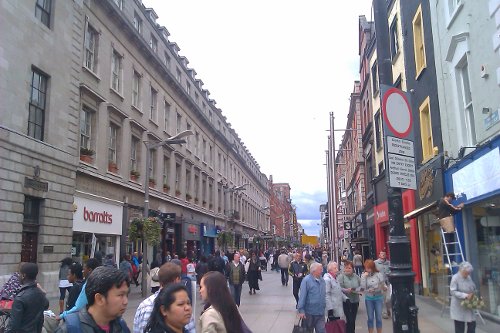
North of the Liffey, the pedestrianized Henry Street runs west from O'Connell Street
On the day we were there, a farmers' market was operating on a side street.
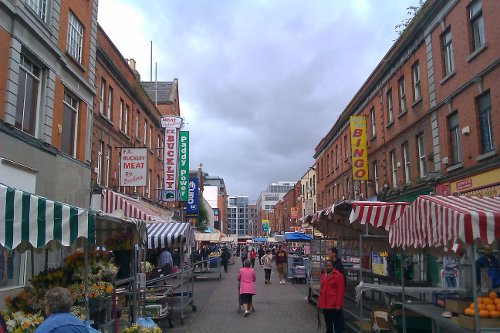
Farmers' Market just off Henry Street
A block south of Henry, the Luas (Irish for "speed") Red Line tram runs east-west along Upper Abbey Street as part of its 16 km range. Launched in 2004, the Luas has been an amazing success, carrying 90,000 passengers a weekday and 26 million passenger trips a year (as in other cities, ridership dropped a bit during the economic crisis).
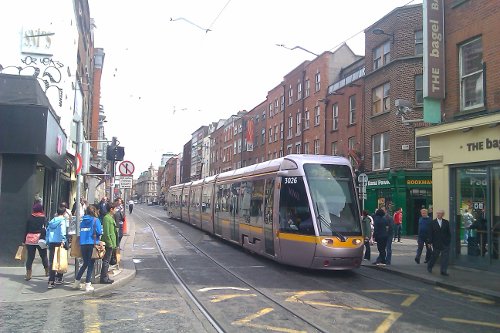
The Luas LRT runs along Upper Abbey Street, north of the Liffey
The construction was publicly funded, but the service runs without public operating funds and runs an annual surplus in operating revenue. The lines have already been extended, and several more extensions are in the works.
South of the Liffey, Dublin's famous Temple Bar is a narrow, winding, cobblestoned lane of medieval streetwalls hidden behind the Merchants Arch, south of the Ha'penny Bridge over the Liffey. (My eight-year-old exclaimed, "It's Diagon Alley!")
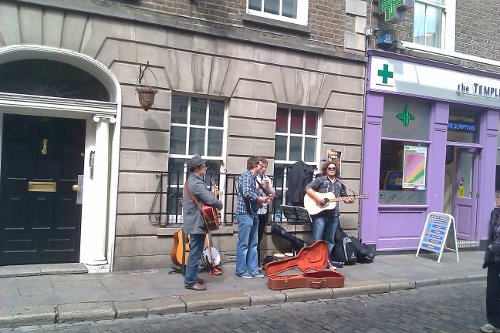
A band performs in Temple Bar
Thick with street performers and given over almost entirely to galleries, pubs and restaurants, Temple Bar feels a bit more touristy than functional. At the same time, 3,000 people live there and it's an important cultural hub, hosting several arts institutes and a weekly book market.
A little further east, Grafton Street runs north-south from College Green, just south of the Liffey, to St. Stephen's Green. Paved with red bricks and framed by eclectic 19th and early 20th century four-storey buildings, Grafton is one of the most beautiful shopping districts I've ever seen.
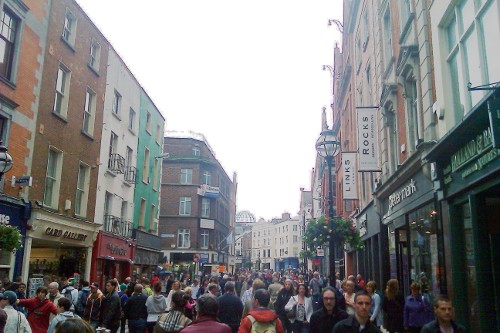
Pedestrian-only Grafton Street is a major destination for shoppers and browsers
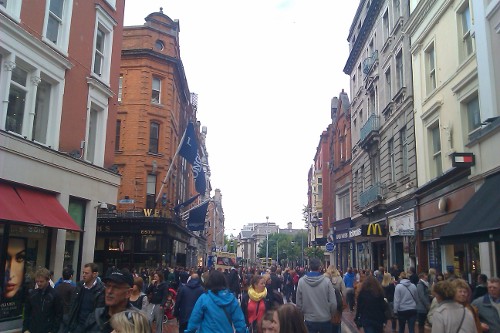
Shops line Grafton Street
Like Henry Sreet, it was pedestrianized in the 1980s and is an extremely popular shopping destination. It also commands some of the highest property square footage rates in the world.
Like Temple Bar, Grafton Street plays host to some fantastic street performers. (If you watched Once, Glen Hansard's character is seen busking on Grafton Street in the movie's opening scene. Hansard himself started out as a Grafton Street busker.)
On the other side of the country, Galway City in western Ireland sits nestled against Galway Bay, which opens into the Atlantic. With a population of just 75,000, it is the third largest city in Ireland and the fastest-growing.
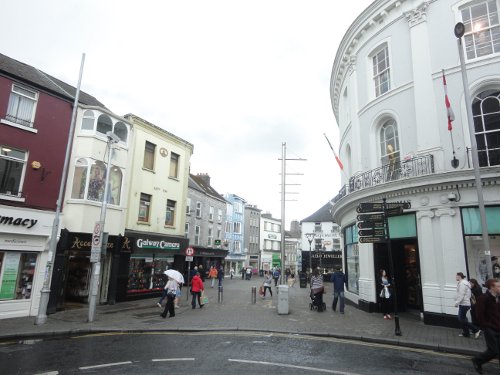
Entrance to Shop Street in Galway City
The central business district, based around Shop Street, was converted to a pedestrian-only street in 1998 and has since enjoyed tremendous success as a popular public space for shopping, strolling, browsing, people-watching and enjoying the many excellent street performers.
The pedestrianized area is usually referred to as "Shop Street" but also encompasses Eyre Square West, William Street, Main Guard Street, High Street and Quay Street. It runs from Eglinton Street down to the east bank of the Corrib River near its mouth.
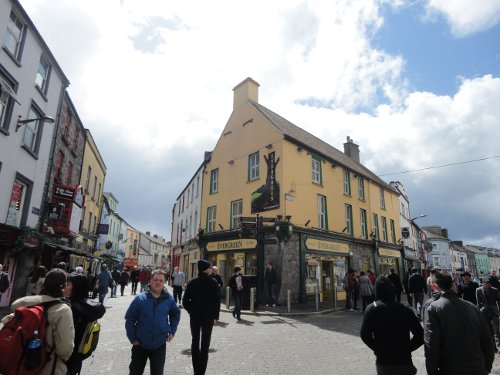
Shop Street runs into Mainguard Street and High Street
The pedestrianization happened despite strong opposition from local shopkeepers, who were afraid that removing cars would hurt business. Nevertheless, it has been a tremendous success that has kept downtown Galway City lively and economically viable while other city centres have been bled by cheap box stores in the suburbs.
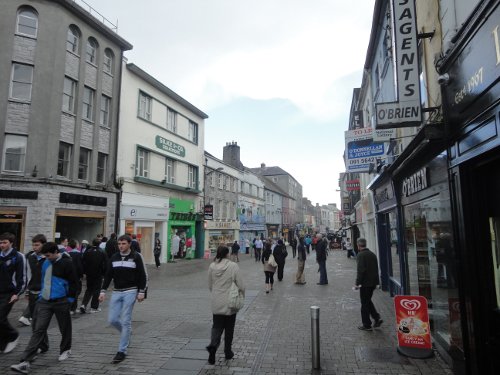
Even on a Monday, Shop Street is pretty lively
Astonishingly, despite the fact that the original fears were proven wrong, a 2009 proposal to expand the pedestrian area from Shop Street onto Williamsgate Street and Eglinton Street elicited the very same fears from local business groups as the original 1998 proposal.
[B]usiness representatives have this week voiced concern that Galway could become get a reputation as an "unfriendly city" for cars and could drive customers away from the heart of the city.
Meanwhile, during a debate over the proposed pedestrianization of a downtown commercial street in nearby Sligo Town, the mayor voiced what most supporters of pedestrianization already understand:
Shop Street in Galway has been a huge success but there was fierce initial opposition to the proposal. I know a businessman, Sean Hynes of Hynes Shoes, who had serious reservations at the beginning, but everyone can now see the obvious benefits pedestrianization had for Galway city in general.
If you create a comfortable, attractive, inviting public space and make it easy for businesses to invest there, people will frequent it.
Galway City has some of the most dismal weather in Europe - it's nearly always cold and wet - but that doesn't stop people from enjoying the beauty and amenity that Galway's pedestrian-friendly core has to offer.
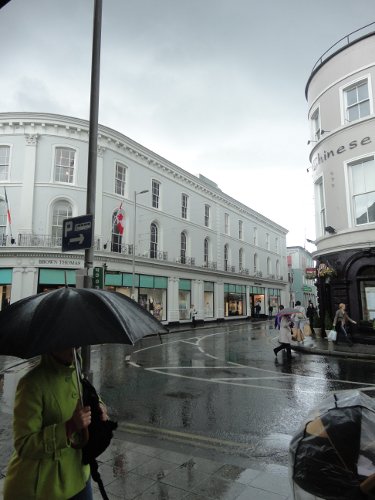
Rain does not deter pedestrians from beautiful public spaces
It is important to note that even those parts of the downtown core that aren't pedestrian-only are still pedestrian-friendly. Elegant streetwalls, wide sidewalks, narrow driving lanes, curbside parking and street trees conspire to produce an environment in which pedestrians feel comfortable and protected.
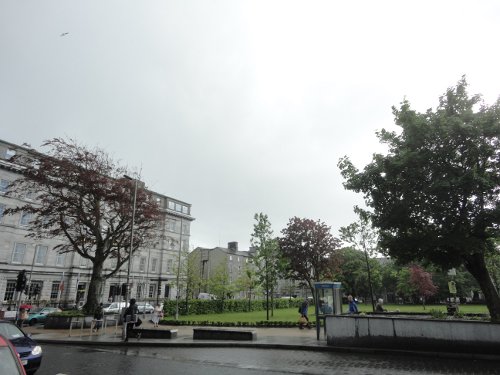
Nearby Eyre Square provides yet another attractive place for citizens to congregate and enjoy their city
While myopic business representatives worry that making Galway more pedestrian-friendly might send the message that the city is "anti-car", the lively urban environment continues to attract artists and other creative people.
Like Dublin, it has become a major cultural centre and hosts a large number of music and art festivals and other events. The economy remains strong through Ireland's economic crisis, in part through its role as a major tourist destination.
Finally, in the south of France, the city of Carcassonne provides another example of a pedestrian-friendly downtown environment. With a population of 50,000, Carcassonne is smaller even than Galway and has a comparatively large suburban ring around the historic downtown. (It also has a medieval castle, restored in the 1800s, overlooking the city from a nearby hill.)
The downtown core of Carcassonne is approximately a seven-by-seven grid of narrow one-lane streets that frame short blocks of two- to four-storey buildings in the French style.
It is surrounded by a ring of boulevards lined with platane trees (similar to the sycamore trees in front of Hamilton's City Hall), tall trees with broad, leafy canopies and mottled, camouflage-like trunks. The boulevards also have angled parking for people heading into town from the suburbs.
The central north-south lane, Rue Georges Clemenceau (colloquially called Rue de la Gare because it runs to the train station just north of the core), is pedestrian-only and lined with shops, cafes and restaurants.
Right at the centre of town on the west side of the Rue de la Gare is a cobblestone pedestrianized plaza called the Place Carnot, which features a central fountain and statue. Framed with platane trees and surrounded by cafes, restaurants and bars, the plaza is crowded with tables and chairs in which people sit under umbrellas and enjoy life.
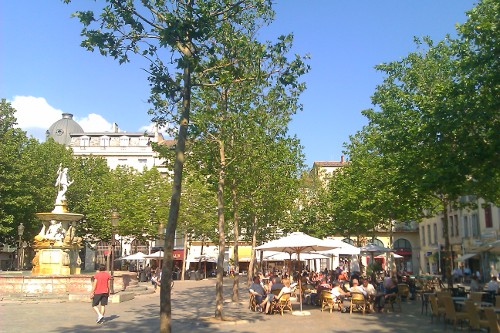
People relax in Place Carnot
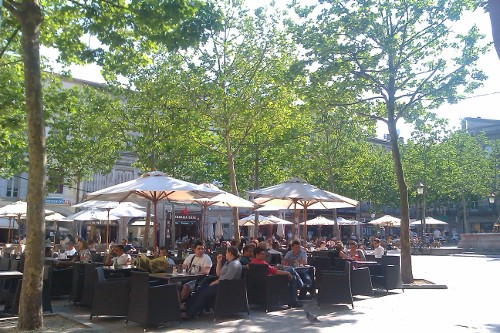
Umbrellas and tree canopies shade the patrons
On Market days - Tuesdays, Thursdays and Saturdays - the seating shares space with a lively farmers' market featuring local fresh produce, breads and pastries, cheeses, preserves and other artisinal goods.
The market attracts tourists, to be sure, but it's clear that the majority of people frequenting Place Carnot are residents enjoying their city.
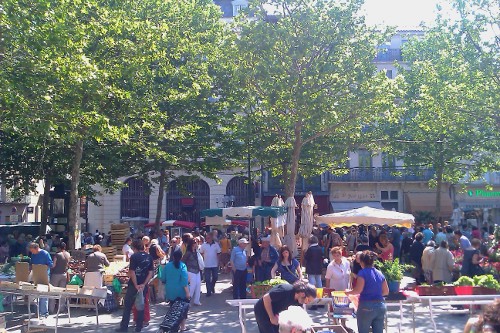
Saturday Market in Place Carnot
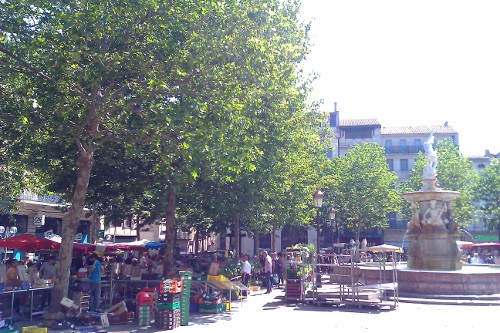
Does this look anything like another central city plaza you've seen?
As we were preparing to leave, they were just setting up the main stage in the Place Carnot for the Festival de Carcassonne, which promises a hugely diverse roster of performances - including Bryan Ferry, Moby, Iggy and the Stooges and, er, Supertramp. Not bad for a city of 50,000.
The pedestrian places I visited all had some things in common:
Places that are attractive, feel safe, and provide a variety of uses and amenities at all times of the day will succeed as people places.
Business owners who fear that the loss of easy motoring access will drive away patrons must remember that they gain far more than they lose: in a city neighbourhood, a beautiful, functional public environment that draws thousands of people every day is better for business than any number of driving lanes or parking spaces.
By jason (registered) | Posted May 26, 2011 at 14:05:12
Dude, you're killing me with those pics....sigh.... we get parking meters and 5 lane truck freeways.
By z jones (registered) | Posted May 26, 2011 at 14:26:27
They could inspire Hamilton.....if our leaders were capable of being inspired.
By CaptainKirk (anonymous) | Posted May 26, 2011 at 14:34:49
But how do they get to Stoney Creek in 4 minutes or less?
Sigh. You just don't understand, Ryan. You see, Hamilton is different; it won't work here.
By JM (registered) | Posted May 27, 2011 at 08:46:48 in reply to Comment 64040
"but this is Hamilton!!!" lol
By Nord Blanc (anonymous) | Posted May 26, 2011 at 15:20:09
Wikipedia provides density stats.
Dublin = 4,398/km2
Carcasonne = 732/km2
Hamilton = 451.6/km2
Trivia: The core of the Golden Horseshoe has around the population of Ireland.
By jason (registered) | Posted May 26, 2011 at 15:28:29 in reply to Comment 64042
Hamilton's lower, urban city is around 1,500/km2. Downtown core is even higher. http://www.raisethehammer.org/blog/1159
Comment edited by jason on 2011-05-26 15:28:39
By Art Brut (anonymous) | Posted May 28, 2011 at 12:36:31 in reply to Comment 64043
Wikipedia fixes Mississauga's population density at 2,544 per square kilometre. I imagine that the area directly adjacent to Square One is even higher. Despite the sprawl that spun off of its wealth of high-volume roadways (on a per-acre basis, higher than even Hamilton, I would guess), it has embraced height and density with far greater enthusiasm than its western neighbours:
Oakville = 1,195/km2 (total)
Burlington = 885/km2 (total)
Hamilton = 1,500/km2 (lower urban only)
It'll be interesting to see if Mississauga will be able to reverse-engineer a downtown simulacra before we are able to rescue our own.
By Art Brut (anonymous) | Posted June 20, 2011 at 16:55:48 in reply to Comment 64144
A quick survey of the towers around Square One reveals upwards of 3,100 new high-polish units added to the city's residential stock in the last 10 years with a walkability score of 90 or higher.... in the estimation of the good folks at Walkscore.com, "a Walker's Paradise." This would include:
97 = Onyx @ 225 Webb Dr
97 = Solstice @ 223 Webb Dr
97 = CityGate West @ 3939 Duke Of York Blvd
97 = CityGate East @ 220 Burnhamthorpe Rd. W.
97 = Grand Ovation @ 3888 Duke of York Blvd
• Ovation North @ 3880 Duke of York Blvd
• Capital Condos @ 4080 & 4090 Living Arts Dr. Mississauga
• Grand Residences of Parkside Village @ 465 Burnhamthorpe Road West
Averaging 38 storeys per.
Hamilton, meanwhile, can lay claim to just a fraction of that new high-polish unit density in the 90+ range. When it comes down to it, Hamilton can apparently lay claim to a fraction of any high-density residential in the 90+ range added since 2001 (reply with omissions/additions as you see fit):
100 = Annex Lofts (40 units)
98 = Gore Building (16 units)
98 = FilmWorks Lofts (50 units)
98 = Hamilton Grand *
97 = Acclamation Lofts *
93 = Chateau Royale (192 units)
92 = Terraces on King (123 units)
90 = City Square Condos *
90 = Core Lofts (103 units)
87 = Witton Lofts/W Lofts *
Averaging 8 storeys per.
So that's looking like around 525 units added since 2001. We can make some gains through the projects in the pipelines, but even those will only bring us up to around 800-900 units. And few would of comparable quality to the average stock available around Square One. The volume is maddening: From the sample above, you can find 2,308 units with a Walk Score of 95 or higher; the comparable Hamilton sample gives you 106.
By Art Brut (anonymous) | Posted June 21, 2011 at 10:35:07 in reply to Comment 64995
Overlooked the fact that 465 Burnhamthorpe Road West has siblings in the Residences of Parkside Village (584 units) and The Park Residences (286 units), both with a Walk Score of 90, pushing Mississauga's 90+ residential stock above 4,000 units. And the gulf may only grow wider. All three Residences are part of the Parkside Village complex (6,000 high-rise, mid-rise and townhouse units in an 11-block area) discussed here briefly a few years ago:
http://www.raisethehammer.org/blog/920
By Art Brut (anonymous) | Posted June 28, 2011 at 11:25:44 in reply to Comment 65004
In the chicken-and-egg proposition of urban renewal, insufficient density arguably neuters the chicken.
100 = Annex Lofts (40 units, 2004)
98 = Gore Building (16 units, 2008)
92 = Terraces on King (123 units, 2008)
All patiently awaiting ground floor retail interest.
Also...
http://www.mississauga.ca/portal/residents/downtown21
Could we be looking at a 100:1 ratio of 90+ housing density in our respective cores by 2020?
By Art Brut (anonymous) | Posted June 29, 2011 at 13:55:11 in reply to Comment 65249
A comparison of core density targets illustrates a fundamental chasm in urban maturity – with Mississauga anticipating 10 times the density in half the time of Hamilton.
Excerpt:
Matthew Williams sees Mississauga’s plan for a $1.2 billion light rail line (LRT) along Hurontario St. as being about more than just transit. He believes the LRT is an essential part of an ambitious strategy to make the city a better place to live.
“It’s really about creating a vision for change,” says Williams, a city transportation planner who led a study that identified the LRT as the best transit option for Mississauga’s primary thoroughfare.
The proposed LRT line would run along Hurontario St. — the city’s busiest corridor — connecting Port Credit to downtown Brampton with as many as 32 stations on the 20-kilometre route.
The LRT line would come off Hurontario and run through *Mississauga city centre, where up to 120,000 new residents are expected within the next decade.*
http://www.thestar.com/news/transportation/article/1014803--mississauga-s-better-way
vs
The city's official plan, based on provincial urban growth targets, has set a goal of 250 residents and jobs per downtown hectare by 2031. But the city needs to *add about 12,000 people living or working downtown over the next 20 years* to meet the target and will fall short if it doesn't increase the rate of growth of about 300 per year over the last decade.
http://www.thespec.com/news/business/article/475520--downtown-is-a-happenin-place
By Art Brut (anonymous) | Posted June 28, 2011 at 13:39:44 in reply to Comment 65249
Coincidentally, sitting down to the Spec over lunch today I was treated to the Perspectives Mississuaga 2011 publication, featuring stories on "Embracing a Culture of Innovation," "Building on Success for a Prosperous Future," "Building a Knowledge Economy", "U of T Mississauga Builds Campus of Innovation," "Mississauga's New Downtown," plus articles on the city Living Green Master Plan and Sheridan's new 1,760-student business campus, designed by Rounthwaite Dick & Hadley Architects and opening at Duke of York Blvd and Prince of Wales Drive this September. It's kind of like McMaster's forthcoming Wilson Building, only with business students instead of liberal arts majors. And a third larger. And in the city centre -- Walk Score of 95, in case you were wondering.
By Nord Blanc (anonymous) | Posted May 26, 2011 at 15:48:31 in reply to Comment 64043
Missed that. Thanks!
Let's see... Ward 2 population density is 23.44 people per acre (despite it boasting the city's highest population of single occupancies), one acre is 0.004046 km².... er, 1 square kilometer = 247.105381 acre... um, help?!
Also: RTH should have a word with Wikipedia.
By matthewsweet (registered) | Posted May 26, 2011 at 22:25:58
Lived in Dublin, was a 10 minute walk to Henry and 15 minutes to Temple Bar where I worked. Great city, never in that walk to and from work did I have to dodge streaming hordes of vehicles, more likely I had to dodge all the other pedestrians.
By Mr. Meister (anonymous) | Posted May 27, 2011 at 01:07:28 in reply to Comment 64055
Your post explains it all. You lived within a short walk of everything. In Dublin because it is so small, only 10% of the area of Hamilton, everything is close. In Hamilton not so much. The key to making a pedestrian only area work is getting people there and back home. There is no point of a pedestrian zone if it is difficult for people to get there and then to return home. Imagine all of Hamilton's citizens living between the harbour and the escarpment and between the university and Kenilworth. That approximates the size of Dublin. Then imagine another million people living in the immediate environs. Before you are done using your imagination, imagine Hamilton being the most populace city in the whole country. Not just the most populace city in the country but having almost a quarter of the country's population. That gives you a pretty good idea of how Hamilton relates to Dublin. Does that not paint the whole comparison in a totally different light? Like so many other things that European cities do so well it all about area and density. That is why Dublin has 3 fairly large pedestrian Zones and will probably have more in the near future.
That being said I think that Gore Park and the South Branch of King is one of the very few places that could and should be a pedestrian only zone. But still allowing all the north south streets to continue to go through. The other one that comes to mind off hand is Hess Street between King and Main and George Street between Queen and Caroline (it already is from Queen to Hess.)
I have some concerns about how Gore park would turn out with so much poverty and and so many undesirables in the area. But on the other hand it is within walking distance of some nicer apartments, condos and office buildings. It certainly already has a transit presence. I think it would take some work and a fair amount of policing but the end results, if it is done correctly, might be worth it. I can imagine a police presence on horseback being a frequent occurrence and a draw in its own right. (I am a really big fan of the police horses) I do not know how long it would take to get real shopping there and that would be a real boon to making it work. Dollar stores and pawn shops just will not make it work well. If the Connaught were to be renovated into apartments or condos that would be a really big step in the right direction. Maybe, just maybe, having that kind of pedestrian zone at its doorstep might be just the spark it takes for that to happen.
There are so many bars in the Hess Street area that I would like to see them institute some kind of shuttle bus system between them to bring customers to the area and return them home. At least one other bar downtown already does that to bring customers in but not necessarily to get them home. I know we have transit but that is not always the best solution for a bunch of drunks and the last bus to get drinkers back to the university leaves shortly after 1 and the bars are open a lot later than that. Things like that done in conjunction with a pedestrian only zone would go a long way to making it work.
In the end with the needed investment being so small I think we should make it happen.
I really appreciate your noting the Luas Red Line tram operating with a profit without being subsidized. The next transit system in North America that operates at a profit will be the first one to do so.
By LoveIt (anonymous) | Posted May 28, 2011 at 12:38:25 in reply to Comment 64059
"(I am a really big fan of the police horses)"
I'd also like one of their horseshoe on my house.
By mystoneycreek (registered) - website | Posted May 27, 2011 at 11:08:14 in reply to Comment 64059
I'm such a sensitive bunny. Articles such as this, with comments such as Mr. Meister's...and the subsequent down-voting...just make me sad. (And sigh.)
I've been to Dublin. Spent St. Patrick's Day there six years ago. It's a wonderful place. Ryan presented the city very well. (And elicited some strong memories.)
Transformation of cities is always possible. But...but...
But this city (and you can read that as 'its people, its politicians, its Id, however you wish) has some tremendous limitations on it. One that strikes me immediately is the seeming negativity projected on the idea of an authentic 'downtown'. You know, the likes of which we've had in the past at various points. (Those looking to accuse me of living in the past and therefore having no stake in the future...can see me personally after class.) Dublin is a traditional urban-based city. Not 'exclusively', no. But its density and habits speak volumes in this discussion. Hamilton? Well, especially with this being 'The Recently Amalgamated City of Greater Hamiltonia', no. Not only 'no', but the amount of near-enmity regularly projected towards those who DO believe in the concept and importance of a downtown core is...I have to say, sigh-inducing, too.
Lots more to say here, especially the basic truth that British Isles towns and cities and those in Europe are an entirely different kettle of fish to what we have in front of us. I'm not dismissing Ryan's exhortations...neither am I aligning myself with the likes of Moylek...but this discussion is a lot more complicated than merely pointing out possibilities.
sigh
By John Neary (registered) | Posted May 27, 2011 at 07:14:07
The next transit system in North America that operates at a profit will be the first one to do so.
As will the next non-toll road.
By Mr. Meister (anonymous) | Posted June 01, 2011 at 14:47:13 in reply to Comment 64060
Wrong. The 407 got Harris $1 billion. The road is obviously making money for the company that bought it especially the way they have jacked up the rates.
By Pxtl (registered) - website | Posted June 01, 2011 at 15:06:09 in reply to Comment 64401
Actually, the 407 company claims to be operating at a substantial loss. Now, this could be Hollywood accounting, but on paper they aren't doing well.
By CaptainKirk (anonymous) | Posted May 27, 2011 at 07:31:46
As will the next park
As will the next snow plow
As will the next school
As will the next police car...
By say what (anonymous) | Posted May 28, 2011 at 01:45:11 in reply to Comment 64061
*insult spam deleted*
Comment edited by administrator Ryan on 2011-05-30 22:45:35
By Mr. Meister (anonymous) | Posted May 27, 2011 at 20:28:21 in reply to Comment 64061
Why are you posting this? Are you trying to make a point? What is it? Do you just like stating the absurdly obvious?
My comment about the next transit system in North America making a profit was directed at Ryan's comment that the Luas in Dublin makes a profit. The possibility of any transit system in North America making a profit any time soon is pretty much a pipe dream. So there was a purpose to my statement. I am confident that you do not like it when facts like that are raised but it is time that you looked at transit in an open and honest manner. Transit is heavily subsidized in North America and yet any small increase in the fare results in dramatically fewer users. It is the old area and density problem that cities in North America face. No amount of wishful thinking and whining is going to change that.
By matthewsweet (registered) | Posted May 27, 2011 at 17:22:14
FYI, Dublin sprawls like crazy as much as any typical North American urban planning nightmare city. I took a bus to an outer suburb for dinner at a family friend's house and it took me an hour to get there, and when I arrived it was a suburban subdivision strikingly similar to what we're familiar with here. So be careful with your oversimplifications about Dublin and "British Iles" towns. Our image of them, and the reality of them are two different things. They are not such a different kettle of fish, despite what we want to believe in order to keep from making changes. Dublin is NOT SMALL.
By Mr. Meister (anonymous) | Posted May 28, 2011 at 09:05:10 in reply to Comment 64106
Dublin has a population of 500,000 and an area of 115 km2, I have not found a quick link to the area of the metropolitan area but from the map it looks to be about 20 or 25 km north south and about 10 or 12 km east west. If my math is correct that leaves an area of less than 500 km2. Less than half of Hamilton. The population of the metropolitan area is 1,600,000. Even if you want to use the urban area population that is still 1,000,000. Hamilton has an area of 1,100+ km2 and a population of 600,000. I am getting my numbers from Wikipedia. If they are wrong then so am I. European cities are built very differently than Hamilton.
By adrian (registered) | Posted May 28, 2011 at 13:43:56 in reply to Comment 64133
European cities are built very differently than Hamilton.
You're right - they were built, and are being built, very differently than Hamilton. As a result, they function much better than Hamilton. Isn't that kind of the point? That we'd be wise to learn from successful cities in order that we, too, may enjoy the benefits of a dense and lively city?
All cities are a work in progress. Dublin was not always the way it is now. Similarly, Hamilton will not always be the way it is now. Failing to provide the experiences and infrastructure that large numbers of people are attracted to - such as safe and pleasant streets, pedestrianized areas, and mass rapid transit - because there isn't enough population density isn't just short-sighted, it's a self-fulling prophecy, because people will stay away and even worse, will leave.
Your logic is like that of the restaurant owner whose business was failing due to lack of customers. He called in a consultant for advice. "The problem," said the consultant, "is that the quality of your food is low. You need to purchase fresher ingredients and spend more time preparing better food."
"Why should I waste my time preparing good food when no one is coming into my restaurant?" retorted the restaurant owner. "There is no one here to eat it!"
Comment edited by administrator adrian on 2011-05-28 13:44:18
By Mr. Meister (anonymous) | Posted May 29, 2011 at 16:32:44 in reply to Comment 64149
Cities are indeed a work in progress. As was noted above the newer suburbs in places like Dublin are getting to be similar to our own. That is what most people want, their own house. That is why European cities are changing. One of the big differences is the price. Compare the price of a house in burbs of Dublin to a similar house in the burbs of Hamilton and what is the difference in price? I have not looked into it but I bet it is higher there then here.
By what is the truth (anonymous) | Posted May 27, 2011 at 17:59:02
a poster writes: I have some concerns about how Gore park would turn out with so much poverty and and so many undesirables in the area.
Why do you deem people as undesirables?
If people are poor, struggling, would that not affect how they dress? Are you offended by the way people dress, that does not fit in with the so called status quo types, who wear suits and ties and think that they are the top notch people?
Are you really offended by people who may have disabilities, such as ones that are not particularly visible?
If you ask me, the crowd that tends to hang out at Hess Village are an unqouth bunch, the children of the status quo, have have no problem showing their butts in the wind, puking on the sidewalks and whatever else happens when they are drink and falling on their faces. Maybe some parents have no clue, as I have seen young people ( not drinking age) going into a local washroom to change into pretty provocative clothing?
By Mr. Meister (anonymous) | Posted May 28, 2011 at 09:31:52 in reply to Comment 64108
I should have been more specific. Whenever I have ventured downtown I have been met with a plethora of panhandlers. There are more prostitutes and drugs downtown then there are on Upper James and Stone Church. These are the comparisons that the core and any kind of pedestrian space must deal with. For that kind of space to really work it takes an influx of people and money. People with money will not to areas that they feel threatened in or even ill at ease. No people with money than the businesses will close or move away and what is left? A pedestrian area full of drugs, vagrants and sex workers. That is not what most citizens want for the core.
As far as Hess strip goes I tend to agree with a lot of what you have to say. The ones that frequent the area have the money to spend there to keep it going. It is a far cry from the infancy of the area when the Gown and Gavel was one of the few bars if not the only one. Lots of fold music. As far as the underage traffic goes I know that a lot of the 17 and 18 year olds want to go there but I also know that most clubs there are pretty difficult for them to get into. Seems their security personal are pretty good at spotting fake I.D.s. Add to that the frequent police appearances with the stiff penalties for serving minors and it really is not much of a problem. The way they behave is why you and I do not go there. When I recall some of my behaviour when I was a young adult I am not to proud of it either and I believe that is a common thing. Been going on for many generations each one outdoing the previous one. What was once risque and adventurous is now dull and main stream.
The way kids dress is a common point of contention in many families. I know it was for years in our household. My daughter is now into her twenties and it is no longer. These kids (mostly girls) see their idols on the TV in the movies and videos dressed in the most provocative manner and acting in the most lewd way and they see this as normal. They think their parents are just old fashioned and control freaks and will do whatever they can to emulate their idols. Add to that the smattering of parents who just do not care and let their kids dress and behave any way they want and this is what you get.
By Pxtl (registered) - website | Posted May 30, 2011 at 10:40:53 in reply to Comment 64136
You know, every city has panhandlers, including seriously sketchy ones.
In terms of the really nasty stuff, I've seen more naked dicks in the nice, glamorous downtowns of Guelph and Toronto than I have in Hamilton. Tonnes of people want to live in places like Toronto and New York and whatnot, and they have panhandlers there.
Only in Hamilton do we treat poverty like it's a special feature of this city instead of being endemic to living in any city. Cities are the natural collection-pool of the refuse of the area, but somehow we've decided that we get bums and beggers in Hamilton because we suck, not because it's a city.
By Undustrial (registered) - website | Posted May 28, 2011 at 11:39:51 in reply to Comment 64136
Panhandling isn't a crime and panhandling alone poses no actual threat to anyone but the poor dude who might not be able to make enough for food/rent/necessities. People need money to live and panhandling is one of the only legal last resorts out there. It happens downtown because of the far larger pedestrian flows than anywhere else in the city, as much as anything else. And I really don't know that I've ever seen a prostitute on King west of Wellington or Victoria. As for drugs, don't think they aren't mighty plentiful on Stonechurch, in Ancaster, Westdale or anywhere else. Just better camouflaged.
There's some pretty serious moral (not to mention practical and constitutional) problems with removing "undesirable" populations so as to attract others with more spending money.
By Mr. Meister (anonymous) | Posted May 28, 2011 at 17:28:38 in reply to Comment 64141
I never said panhandling was illegal. I said it makes people ill at ease. Most people do not want to deal with it rightly or wrongly that is just the way it is. Most people can even deal with the occasional panhandler but dealing with several in quick succession will put most people off.
No doubt there are some serious moral issues at play here. For a pedestrian zone to work it needs an influx of money like any other commercial zone. No money than the businesses that are there will all close down. Just look at our core today. There is very little money downtown and what do we have? Dollar stores pawn shops and the like. Buildings being ripped down because the owners cannot lease them or sell them. If you are happy with that then nothing needs to change. If you want a different downtown then things must change. One of those changes is the core must start to attract some money. Do you want a pedestrian zone full of vagrants, drugs and sex workers?
By adrian (registered) | Posted May 28, 2011 at 13:49:21 in reply to Comment 64141
As for drugs, don't think they aren't mighty plentiful on Stonechurch, in Ancaster, Westdale or anywhere else. Just better camouflaged.
Or, instead of camouflaged, prescribed. Poor folks with few options who can't handle life any more call their dealer. Middle-class and rich folks call their doctor and get a prescription.
By Mr. Meister (anonymous) | Posted May 28, 2011 at 17:29:36 in reply to Comment 64150
You are right to a degree and I would have been more accurate to say they are more visible in the core.
By LoveIt (anonymous) | Posted May 28, 2011 at 12:58:33 in reply to Comment 64141
The difference is, when you see a panhandler that is old or disabled, you do understand and give some cash. But when there are young ablebody ones, you do not even want to walk by those, nothing to say about your kids.
By jason (registered) | Posted May 27, 2011 at 20:56:30 in reply to Comment 64116
yea, what in the world will everyone do with a measly 28 lanes of major east/west roadway to choose from between Barton and Charlton?
By SpaceMonkey (registered) | Posted May 27, 2011 at 22:09:18 in reply to Comment 64122
I count 10 East bound and 8 West bound lanes of major roadways. Surely one wouldn't count a lane of on street parking as "major east/west roadway".
By jason (registered) | Posted May 28, 2011 at 09:01:57 in reply to Comment 64127
King, Main, Cannon and Wilson total 19 lanes on their own. Add in Barton, Charlton, Hunter for another 6-8 depending on which stretch you're on. Burlington St, just north of Barton, adds in another 2-4. Oh, and did I mention that the lower city is about 2-3 km wide? That's a heck of a lot of major roadway lanes for such a small area. Hamilton has the most lanes of road/highway per person than any city in Canada. The LAST thing that we need to worry about in making decisions is where oh where will people drive.
By Mr. Meister (anonymous) | Posted May 28, 2011 at 17:36:54 in reply to Comment 64132
I think your addition is off a little. At there narrowest King is 2, Main is 3 Wilson is 1 in each direction, Barton is 1 in each direction and Wilson is 3 and now 1 due to construction. The way I was taught math that adds up to 12 with Barton a far cry from 19 plus Barton. It is the minimum number of lanes that really determine the traffic handling capabilities of a road. When ever I go through the area I see a lot of traffic so I seem to think that it is being used. Hamilton has traditionally been an east west city because of the lake and the hill.
By Pxtl (registered) - website | Posted May 28, 2011 at 21:13:32 in reply to Comment 64154
You aren't counting parking lanes.
By Mr. Meister (anonymous) | Posted May 29, 2011 at 16:35:34 in reply to Comment 64160
Correct because we were talking about traffic lanes were we not?
By SpaceMonkey (registered) | Posted May 28, 2011 at 09:51:05 in reply to Comment 64132
West Bound (11 lanes) King = a combination of 2, 3, and 4+1 lane of parking. I'll give you the benefit of the doubt and take the widest stretch for sake of argument.
Cannon = 4 (even though 1 lane is for parking at many points along the way)
Burlington St = 2
East Bound (11 lanes) Main = 4 + 1on street parking but I'll give you 5
Wilson = 3 + 1on street parking but I'll give you 4.
Burlington St = 2
I can't imagine how Barton, Charlton, or Hunter could be considered "major roadways" in the context of carrying lots of cars efficiently east/west. So, I think it's fair to take those out of the equation and for the sake of argument add in the lanes of on street parking. So, even being generous, I count 22 lanes of East/West major roadways (although I think 20 would be more accurate). 11 going in each direction doesn't seem excessive to me.
By DBC (registered) | Posted May 28, 2011 at 11:36:51 in reply to Comment 64138
Oh good. Does that mean that we can now have Hunter and Charlton converted to two way so that traffic can be calmed in order to increase the liveability of the surrounding neighbourhoods?
I suppose Herkimer should be converted also.
By SpaceMonkey (registered) | Posted May 28, 2011 at 12:28:42 in reply to Comment 64140
I'd be fine with that.
By Woody10 (registered) | Posted May 28, 2011 at 09:07:15
The problem stems from not having the systems in place 50 years ago like virtually all major/mid European cities did, if not before. We are playing catch up and paying for it in spades. Nobody wants to be the one to say "pay up or shut up" it's too political and the province, feds and city all play off each other over any major investment. No balls politics.
By SpaceMonkey (registered) | Posted May 28, 2011 at 09:30:12 in reply to Comment 64134
I think you raise a good point Woody. It would be interesting to see the cost of labour and energy 50 years ago compared to now. I'm guessing that labour and energy are extremely more expensive now than they were back then, and therefore building big projects like railways are much harder to do, financially, than they were 50 years ago.
By Undustrial (registered) - website | Posted May 28, 2011 at 11:44:56 in reply to Comment 64135
Yes and no.
Labour is at least twice as productive per person/hour now as back then, due to more technology and greater efficiencies. And wages have been stagnating or falling for most labourers since the early 1970s.
On the other hand, the cost of administration has skyrocketed. So while that labourer might be producing far more per hour or dollar of wages, the project's budget will probably come in at several times what it would have back then.
By Mogadon Megalodon (anonymous) | Posted May 30, 2011 at 10:27:46
It seems to me that the missing factors here are (a) continuum of generational identification with downtown core dating back centuries; and (b) premium cultural valuation placed on (and, accordingly, prioritized preservation of) architectural heritage, two variables that you tend to find across Europe in part because of the length of time its cities were in development using manual construction technology – Dublin, Galway and Carcassonne date back over 800 years, while Hamilton grew out of a settlement of American refugees just over 200 years ago, if you factor out indigenous populations (which settlers were keen to do). You can also find that to a lesser degree in French Canadian cultural preserves such as Montreal. The European view is reflected in cultures still older, of course. Ancestry is important. Cultural identity is important. Architectural legacy is This is, in part, why places like Piazza Del Campo, Piazza San Marco, Grote Markt, Place Jacques-Cartier etc don’t look like Yonge-Dundas Square or Gore Park.
One visit to the Spec’s goggle-eyed comments roll or dialing in the scruffy mental haze of the CHML signal is all it takes to find scores of Hamiltonians who’ve divorced themselves from the lower city entirely – to say nothing of the downtown core – all based on biases that date back to the 70s and 80s. I would guess that they might also be less than conversant in their city’s history, focused as they are on what’s new and novel. That habit of thought is, I would suggest, no small part of Hamilton’s urban retardation. It is as prevalent in out-of-town developers as it is in the population. And deprogramming the lot will be far more challenging than the bureaucratic tedium of invoking two-way streets.
By mystoneycreek (registered) - website | Posted May 30, 2011 at 11:39:16 in reply to Comment 64215
One visit to the Spec’s goggle-eyed comments roll or dialing in the scruffy mental haze of the CHML signal is all it takes to find scores of Hamiltonians who’ve divorced themselves from the lower city entirely – to say nothing of the downtown core – all based on biases that date back to the 70s and 80s.
That's a little off...even though I agree heartily with the notion that many have 'divorced' themselves as you say. (Naturally, I'm inclined to point out the magnification of this via our beloved amalgamation...but that's as far as I'll go for now. LOL)
Despite how historical revisionists would love to look at the downtown as having been eviscerated as of The Debacle That Is Known as Jackson Square (or by its initial moniker), the fact is that downtown was doing fine through the 80s. I know, I lived there...and worked there, too. I was there when it all began falling apart, and even if you process things as 'the seeds were already planted', we had a few more 'good years' downtown than what you're suggesting. Why people would have biases developing in the 70s is beyond me. Twenty years later, however... Oi-friggin'-vey...
By Mogadon Megalodon (anonymous) | Posted May 30, 2011 at 12:09:24 in reply to Comment 64221
I'm probably drawing lines a little broadly, but the '70s bias is I think mostly the mess of Jackson Square construction, which ripped up a huge stretch of the core.
That project was itself rooted in the previous decade's belief that the downtown was failing and in need of radical reworking.
Megablock projects such as Jackson Square actively seek to redefine psychogeography. JS erased buildings and streets from the landscape. Some people will see an improvement, while others won't. Ditto for the demise/demolition of historic retail establishments through the 80s and 90s.
But it's not a new trend, by any means. Of any city in Canada, Hamilton is the most obviously a product of the Industrial Revolution, and it has that thinking engrained in its DNA. The city has been razing old buildings almost as long as it has been putting them up.
By BoBra (anonymous) | Posted May 30, 2011 at 11:44:36 in reply to Comment 64221
I think you're remembering things with slightly rose colored glasses, they built Jackson Square etc. in the 1970's and 80's over calls that downtown was suffering and needed renewal. Problem is they "renewed" it by wrecking the only parts that actually worked.
By Undustrial (registered) - website | Posted May 30, 2011 at 23:45:10 in reply to Comment 64223
"The urban renewal plan for the downtown area as submitted by Murray Jones, called for acquisition and total clearance of almost forty-four acres of land in the central core of the city, adjacent to the new city hall, Gore Park and the main business and commercial districts - a choice piece of property having ready access by public and private transportation as well as high concentrations of pedestrian traffic generated by nearby high-rise apartments, offices and shopping ares. Jones' economic study of this area claimed it had become obselete and inefficient. Eighty-two percent of the buildings were built before 1900, and tax revenue from the area was very low. Altogether there were some 260 businesses with 500 people living in apartments over the stores. Some of the businesses, like Eatons, were large and prosperous, but the vast majority were small merchants and manufacturing firms that eked out a marginal existence." - Their Town, Bill Freeman and Marsha Hewitt.
This process started in 1964, and work began on "Civic Square" in 1967. By 1970, it had been turned over to Yale Properties from First Wentworth, a Pigott subsisidiary.
They tore a hole in downtown. By the seventies, it had already consumed a large chunk of the core and over the next few decades it devoured many more. Many of the brilliant initial plans didn't come to pass (like outdoor pedestrian malls), and others just didn't work out. But all this rhetoric about downtown being in need of big redevelopment projects is downright ancient.
By Mogadon Megalodon (anonymous) | Posted May 30, 2011 at 10:34:01 in reply to Comment 64215
Added to which, of course, the French and Irish have both been disinclined to allow themselves to be assimilated into Anglo culture, for various reasons but with similar rigour. Hamilton, despite the tired "Toronto Sucks" banter, has generally been pathologically needy, seeking the approval of outsiders rather than shoring up its own foundations. The irony is that it has taken a wave of real estate refugees, many of them from Toronto, to shake up this mindset.
By Mogadon Megalodon (anonymous) | Posted May 31, 2011 at 07:42:16
Thanks for the timeline.
The dirt lot aspect was what I was getting at in my earlier post. What people see now is just the deadening megablock. What they forget was that this area stalled out for a number of years between the time that they levelled 40+ acres of downtown and the time that work began, and years again before its first phase would open to the public: from 1967-1972 that was essentially dead space.
This was complicated by the telescoped, spaghettied project scheduling of the "Civic Square" redevelopment:
1972: Phase 1 opens
1972: Bank of Montreal building opens (1 James North)
1973: Stelco Tower opens (100 King West)
1973: Hamilton Place opens (1 Summers at Main)
1977: Phase 2 opens
1977: Robert Thomson building opens (110 King West)
1977: Art Gallery of Hamilton opens (123 King West)
1980: HPL Central Branch opens
1981: Hamilton Convention Centre/Ellen Fairclough Building opens (King/MacNab)
1983: Standard Life tower (120 King West)
1985: Sheraton Hamilton opens
1985: Copps Coliseum opens (101 York Blvd)
Related to this, you have:
1969-70: US recession
1971: IBM Tower opens (Main/MacNab)
1971: Closing of the Capitol Theatre
1972: Demolition of the Palace Theatre
1973: Birks building demolished
1973: Oil Crisis I
1974: Century 21 Building/Landmark Building completed
1974-75: Recession
1976: First Place opens (King/Wellington)
1976: York Boulevard facelift
1976: Spectator moves out of downtown
1973: Oil Crisis II
1981-2: Recession
1983: Gore Park Massacre
1987: Commerce Place I opens (King/James)
And you'd also have the loss of the historic Eatons building in the late 80s as well.
By Fred Street (anonymous) | Posted May 31, 2011 at 10:10:27 in reply to Comment 64281
1967-1985 = Hamilton's Civic Square
1987-2005 = Boston's Big Dig
By Fred Street (anonymous) | Posted May 31, 2011 at 08:47:05 in reply to Comment 64281
As well, Sir John A. Macdonald Secondary opened in 1970 at the NW corner of the Civic Square precinct and at the headwaters of the York Boulevard project.
By Mogadon Megalodon (anonymous) | Posted May 31, 2011 at 07:55:52 in reply to Comment 64281
And it's hard to imagine a contemporary equivalent of this...
Mar 1980-Aug 1981: 125-day strike at Stelco results in return of 10,700 workers
Dec 1981-83: Stelco lays off 6,600 workers
By Nord Blanc (anonymous) | Posted May 31, 2011 at 22:32:43 in reply to Comment 64282
Hamilton's population in 1980 was 306640... with 10,700 on strike, that's around 2.8% of the total population on strike... for almost 17 weeks. The 2006 equal would be 14,100 on strike and around 10,000 laid off afterward.
For sake of comparison, the legendary and historic 1946 Stelco strike involved around 2,000 workers; the city's 1945 population was around 175,400.
By Mogadon Megalodon (anonymous) | Posted May 31, 2011 at 07:57:15 in reply to Comment 64282
Gah – disregard the months.
By Pxtl (registered) - website | Posted June 01, 2011 at 15:08:49
As an aside, I can't be the only person craving some boardgame action with all this talk of Carcassonne.
By Mogadon Megalodon (anonymous) | Posted June 01, 2011 at 15:46:03 in reply to Comment 64405
I think you're on to something. Maybe this was the real reason for Ryan's recent trip to Europe? (Well, this and, um... Irish Quest?)
If so, I'm looking forward to upcoming posts on "Amalgamation, Food Security and Settlers of Catan", "Hamilton Waterfront Trust and the Wharves of Le Havre", "PanAm Strategies in Lübke & Kramer's Colosseum" and "Tigris and Euphrates: Reflections on Post-Industrial Buffalo, the Erie Canal and the St. Lawrence Seaway".
By Art Brut (anonymous) | Posted June 28, 2011 at 13:50:11
For an illustration of true dedication to intensification, there's this tribute to creative entrepreneurs in the Sunday NYT:
"Two luxury hotels are opening in Gaza this month. Thousands of new cars are plying the roads. A second shopping mall — with escalators imported from Israel — will open next month. Hundreds of homes and two dozen schools are about to go up. A Hamas-run farm where Jewish settlements once stood is producing enough fruit that Israeli imports are tapering off....
For the past year, Israel has allowed most everything into Gaza but cement, steel and other construction material — other than for internationally supervised projects — because they are worried that such supplies can be used by Hamas for bunkers and bombs. A number of international projects are proceeding, but there is an urgent need for housing, street paving, schools, factories and public works projects, all under Hamas or the private sector, and Israel’s policy bans access to the goods to move those forward.
So in recent months, tunnels under the southern border that were used to bring in consumer goods have become almost fully devoted to smuggling in building materials.
Sacks of cement and piles of gravel, Turkish in origin and bought legally in Egypt, are smuggled through the hundreds of tunnels in double shifts, day and night, totaling some 3,000 tons a day. Since the overthrow of President Hosni Mubarak, the Egyptian security authorities no longer stop the smugglers. Streets are being paved and buildings constructed.
“Mubarak was crushing us before,” said Mahmoud Mohammad, a subcontractor whose 10-man crew in Gaza City was unloading steel bars that were carried through the tunnels and were destined for a new restaurant. “Last year we were sitting at home. The contractor I work for has three major projects going.”
Nearby, Amer Selmi was supervising the building of a three-story, $2 million wedding hall. Most of his materials come from the tunnels.
Karim Gharbawi is an architect and building designer with 10 projects under way, all of them eight- and nine-story residential properties. He said there were some 130 engineering and design firms in Gaza. Two years ago, none were working. Today, he said, all of them are."
http://www.nytimes.com/2011/06/26/world/middleeast/26gaza.html?_r=1
Admittedly, Gaza's population is three times the size of Hamilton.
You must be logged in to comment.
There are no upcoming events right now.
Why not post one?